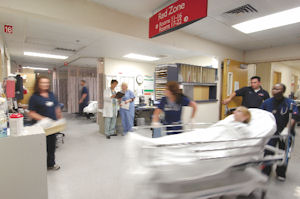Antelope Valley Hospital could soon become the 14th designated trauma center in Los Angeles County – an accomplishment that hopes to further strengthen a hospital that has experienced a dramatic financial turnaround in the last two and a half years. “This is very important to our strategic plan for the future,” said CEO Edward Mirzabegian, who helped take the hospital from a loss of $18 million accumulated before he took over in 2007, to a $1.96 million loss at the end of fiscal year 2008. In fiscal year 2009, the hospital finished with a $4.5 million profit. “By being designated as a trauma center, it shows that we have a higher level of quality care for our critical patients. This level of care attracts physicians and specialists that will only work at a facility with the highest standards of patient care,” he said. Depending on its capabilities, a hospital can be designated as a Level I, II, III, or IV trauma center and/or Level I or II pediatric trauma center (with Level I being the highest) by the Los Angeles County Emergency Medical Systems Agency. In Los Angeles County, there are currently four Level I trauma centers, eight Level II trauma centers and one Pediatric Level I trauma center. Antelope Valley Hospital’s designation as a Level II trauma center awaits final approval from the county after receiving a favorable review from the American College of Surgeons – an association which verifies that hospitals meet all necessary criteria and have enough resources to deliver optimal trauma care. Once the contract is finalized, Antelope Valley hospital anticipates it will become part of the county’s trauma system in the first quarter of 2010. Both Level I and II trauma centers are similar and are required to have trauma surgeons available including those trained in specialties such as neurosurgery and orthopedic surgery and have highly sophisticated medical diagnostic equipment, however a Level I trauma center is required to have additional staff and resources. “Having a trauma center in the Antelope Valley means that trauma patients will be treated faster rather than being flown up to an hour away to another medical center,” said Mirzabegian. Antelope Valley Hospital already has the second busiest emergency department in the state, seeing more than 113,000 emergency patients annually, he said, and it is the only major hospital in a 50-mile radius. From the Antelope Valley, the nearest trauma center in the county is Henry Mayo Newhall Memorial Hospital in Valencia. “There certainly is a need in that community,” said Christy Preston, Trauma System Program Manager for L.A. County EMS. “It’s very isolated geographically and right now the only way to [treat trauma patients in the Antelope Valley] is to airlift them out.” Although the operation of a trauma center is typically extremely expensive as there is no way to schedule the need for emergency services and doctors must be available at all hours, Mirzabegian said the trauma center will represent a good source of income for Antelope Valley Hospital. Part of the operating costs will be offset by reimbursements from insurance companies as well as from Los Angeles County, he said. According to Preston, the county has a program in place that reimburses hospitals for treatment of trauma patients who are indigent. The trauma center designation would be the latest in a long list of improvements that have taken place at the hospital in the past couple of years. The hospital has added staff, upgraded procedures, rejuvenated its facilities, and reduced its debt through a reorganization and restructuring that has touched nearly every process at the organization, Mirzabegian said. To meet the demand for increased medical care in the Antelope Valley – one of California’s fastest growing populations – the hospital expanded its number of beds, and upgraded patient rooms. It restructured the nursing department, increased the numbers of RNs at the bedside, and redesigned nursing stations for better efficiency and patient flow. Among other changes, the hospital upgraded its ER and enlarged its triage area to expedite care of critical patients, while also decreasing wait time for all other patients. For the past two years, Mirzabegian has concentrated on getting the hospital’s finances in order, helping streamline processes through the use of new computer systems and technology. The hospital invested in new software to validate services and help capture costs, he said, and also restructured the interest it paid on debt, all while looking for ways to increase income without raising costs. “It’s day and night,” said Mirzabegian of how different the hospital is now from what it was four years ago. “This place looks different, smells different, and functions different.” The changes will continue in 2010 with the groundbreaking for a new Cancer Center – a joint venture with City of Hope Medical Group – that will take place in the next months. Additionally, the hospital is making robotic surgery an important element of its long-term strategy for growth, Mirzabegian said. Trauma Centers in Los Angeles County Level I Children’s Hospital Los Angeles Harbor/UCLA Medical Center Cedars-Sinai Medical Center UCLA Medical Center LAC+USC Medical Center Level II California Hospital Medical Center Providence Holy Cross Medical Center Huntington Memorial Hospital Henry Mayo Newhall Memorial Hospital Long Beach Memorial Medical Center Northridge Hospital Medical Center Saint Francis Medical Center Saint Mary Medical Center
